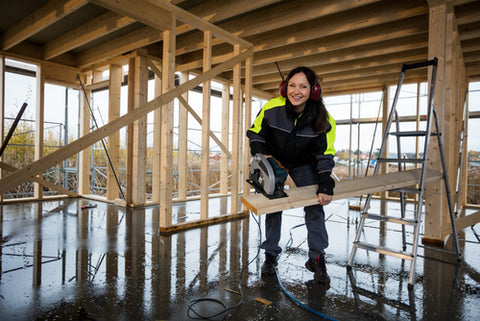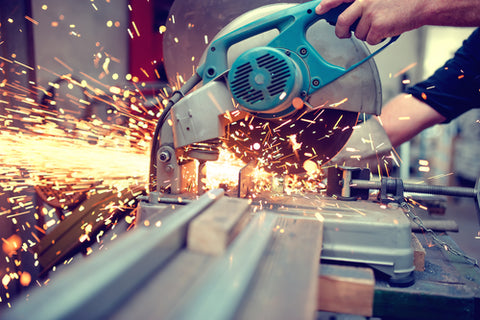It’s a hot topic for debate in the hardware industry: are coated or uncoated saw blades better? Ask a professional, and they’ll likely have an argument prepared for their side of the debate.
All saws—circular, table saw, miter saw, and radial arm—come in a variety of materials, constructions, teeth, and tapering. Nevertheless, whether or not these blades are coated is one of the biggest questions to consider before investing in a new blade.
Below, we’ll go through the pros and cons of coated versus uncoated blades—and how to choose which is right for your projects and toolbox.
Coated saw blades
Most saw blades are made from high-speed steel (HSS). Although it’s still a strong alloy, it’s considered a softer steel than high carbon steel.
A coating typically helps strengthen high-speed steel so it’s stronger and more durable. Hard coatings are usually made of substances like titanium, carbide, and materials.

Advantages
Because coating materials are so resilient, they theoretically produce a harder tooth edge. This creates less resistance and friction when cutting into harsh materials, which in turn leads to less dust and clogging with a smoother finish.
Moreover, the coating creates an even surface on the blade. This makes the blade slicker, so it can cut with less friction than HSS would. This is especially true when cutting into stone materials, which can cause steel blades to reach higher levels of heat, increasing the chances of malfunction or breakage.
Coated blades are also considered to be longer lasting. The coating’s robust substances make it more resistant to wear, scratches, and rust.
Drawbacks
In some cases, these coatings can actually have the opposite effect of their intentions. If the coating isn’t high quality, the friction while cutting strong materials can start to wear away the coating after several uses. The same is true of sharpening the blade. This can start to leave the blade only partially coated, which is aesthetically unappealing and can also expose the blade underneath to impairment.
Some brands of coated blades have a rough and unprofessional layer of coating. This can actually create more resistance, potentially leading to damage to the blade or the project itself.
Plus, coated blades tend to be more expensive. This increased cost is in exchange for the higher-quality materials used to strengthen the durability of the blade.
Advantages recap:
- Reduced resistance
- Minimized friction
- Less dust
- Smooth finish
Disadvantages recap:
- Potentially worn or damaged blade
- Can’t sharpen frequently
- Expensive
Uncoated saw blades
Uncoated saw blades are also referred to as “naked” blades because they don’t have any protective layer on top. The uncoated blade could be high-speed steel (HSS) or a stronger steel, like carbon alloy. Learn more about types of steel blades here.
Advantages
Because uncoated blades are naked, they can be sharpened over and over, and you’ll consistently see the same results. Since a sharp blade is always preferred, this is an important aspect to consider.
Without a coating, you don’t have to worry about any of the drawbacks of a coated blade. The coating won’t wear down, there won’t be undue resistance, and the blade won’t damage as easily during a project. It’s a simple and reliable choice.
Uncoated saw blades are also less expensive and more common than coated saw blades.
Drawbacks
Although the uncoated saw blade is traditionally the tool of choice, it has some disadvantages as well. If the blade itself is weak or poorly constructed, it won’t be able to withhold rigorous cutting for an extensive period of time. The strength of the blade will directly determine your project’s success.
Uncoated blades can also cause friction because they don’t have a smooth coating to create a level surface. This increased friction can slow down cutting times and increase dust and clogging. Softer steel blades also reduce sawing power.
Advantages recap:
- Less expensive
- Simple
- Reliable
Disadvantages recap:
- High friction
- Slower cutting times
- Increased clogging

Notes about coated vs uncoated blades
It’s challenging to decide whether coated or uncoated blades are right for you. Each professional has his own preference, and his preference may vary based on the different types of saws or brands he’s using.
Below are some tips to help make the decision easier.
Use a hybrid.
Some uncoated blades will have coated teeth or teeth made from a harder material. This allows you to get a stronger cut into the wood using the coated teeth, with a smoother finish with the uncoated blade. This kind of hybrid can give you the best of both worlds while minimizing any drawbacks.
Consider the construction.
The blade is only as good as its base. A hard coating won’t last long on weak steel. In reverse, a hefty steel blade may not need a coating (and actually works better uncoated). For example, titanium blades have unparalleled durability—with or without a coating.
Make sure you start with a quality blade from a strong company. The quality of the steel is the quality of the blade.
Purchase a carbon steel blade.
If you want the best quality blade, opt for carbon steel. Although most saw blades are made of some quality of high speed steel, carbon steel is a stronger steel alloy. High carbon steel is considered the best quality blade for a smooth, spotless slice in wood or stone.
Purchase saw blades that are made with high carbon steel:
- Reciprocating Sawzall Blades For Wood
- HCS Oscillating Saw Blades – Fine Teeth For Wood And Plastic
- HCS Quick Release Oscillating Saw Blades – Fine Teeth For Wood And Plastic
Shopping tip: Look for “HCS”, which stands for high carbon steel.
Maintain the blade.
Always take care of your blade, especially if you’re using an uncoated blade. If you take preventative measures, either type of blade will be able to endure in your toolbox for years to come.
Below are our top blade maintenance tips, especially for uncoated blades:
- Wipe and rinse the blade after every use. This removes any corrosive dirt or grime.
- Immediately dry the blade after it’s been wet. Wetness generates rust.
- After use, put oil or wax on the blade. Olive oil can work fine, or you can use a professional-grade steel oil or wax.
- Store blades in dry, cool areas. Damp or moist drawers can cause rusting and corrosion.
- Do not store blades in leather, because leather absorbs moisture.
- Sharpen blades regularly. For regular touchups, use a 1500 grit (or finer) ceramic steel sharpener. On occasion, do a deeper sharpening with your whetstone. Never sharpen with a serrated edge.
- If the blade is rusting, remove rust immediately with rust remover and steel wool (or other preferred rust removal method).
Learn more about how to maintain your tools here.
Select the right brand.
Do your research before committing to a blade. The brand you choose will determine the quality of the steel, the construction of the blade, and the durability of the coating.
Contact Ryker Hardware for more info about our brand and blades.
Which is better: coated or uncoated?
Ultimately, how do you choose between a coated and an uncoated blade?
A number of professionals prefer uncoated saw blades because they’re clean and easier to use. If you maintain your blade well, you can keep these for years to come and also create stunning, smooth-edge projects.
However, despite uncoated being the popular opinion, a lot of us at Ryker actually prefer coated saw blades. That’s because Ryker coating is high quality, durable, and strong. Don’t be afraid of coating—see what works best for you.
But we know the decision can be tough. That’s why the Ryker 15 piece variety set of oscillating saw blades is the perfect solution. It comes with both coated and uncoated blades, so you can give both a try to see what’s most effective for your assortment of projects.
Still not sure which is right for you? That’s okay! Ryker Hardware offers a 60-day Money Back Satisfaction Guarantee to ensure you are always happy with your purchase. Check out our shop now.
Tip: You want our 15-piece quick-release oscillating saw blades. You get a variety pack of blades, so you’re well equipped for every project!

Leave a comment